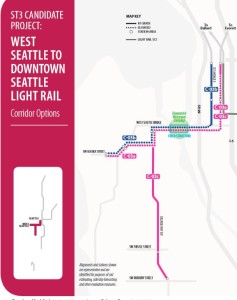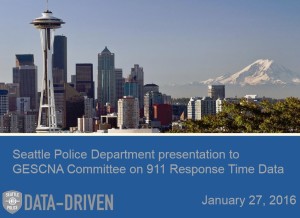Light Rail to West Seattle, 911 Response, and 1st Committee Meeting
 Letter to Sound Transit re: ST3 ballot measure
Letter to Sound Transit re: ST3 ballot measure
The Mayor and Council sent a letter to Sound Transit providing the City’s comments about potential projects for an ST3 ballot measure in November.
For District 1, the letter states Seattle’s support for building light rail from Downtown Seattle to West Seattle, and lists West Seattle to Burien/SeaTac as a potential additional priority.
The letter includes language I suggested requesting Sound Transit work closely with non-profit and community based organizations “in particular in areas with new candidate projects” like West Seattle in advance of the release of a draft plan. Only West Seattle has a brand new corridor (Delridge) listed as a potential candidate project and I believe that there should be meetings with the community surrounding both this corridor as well as the Junction. I also suggested language, at the request of the West Seattle Transportation Coalition, stating Seattle’s desire to work with Sound Transit on integrated station area planning in West Seattle. This language was also included.
The letter also notes Seattle’s request for early delivery transit projects and service enhancements during the time before light rail is built, and mentions funding operation costs for bus rapid transit lines on future light rail corridors to a high level of service.
I’d like to thank District 4 Councilmember (and Sound Transit Board member) Rob Johnson and his staff for coordinating the letter, along with the Mayor’s office, which you can read here.
Briefing on 911 response times 
Earlier today the Gender Equity, Safe Communities and New Americans Committee chaired by Councilmember González was briefed by the Police Chief on 911 response times. I appreciate Councilmember González scheduling this briefing so soon after becoming committee chair.
You can view the presentation here, and the committee discussion here.
The report shows response times are longest for the North precinct, followed by the Southwest precinct. SPD said the number of officers available, and the size of the precinct, are the key variables.
The data is presented for Priority 1 calls, where there is a threat to life and safety. In addition to crime, this can also include car accidents, injuries, and suicide calls. It shows longer response times than the Seattle Times reported earlier this month and previous SPD reports. In the past SPD had used a 7 minute response time as a goal; today we were told that there is no national standard for 911 response times.
I appreciate that the data is now being presented more accurately—a real improvement in how SPD reports data; it is concerning to me to hear that we haven’t identified a goal by which our efforts to respond can be measured. As SPD said today, 911 response time is only one measure of how well a police department is performing. I agree with that. But as a measure to determine how well we are helping a person on the other end of the line, making that 911 call, it is still an important standard and must be used as such.
I asked for data broken down by sector, to see how much variation there is, for example, within the Southwest Precinct covering West Seattle and South Park, and how much distance from the precinct may play a role. I also asked for an update on when we can expect the report to address the staffing needs of SPD to be completed; it was funded in the 2014 budget and we were told today that it is not yet ready for publication. I told SPD that there are members of Council eager to get to the conversation around how to add staffing to that department and would appreciate receiving that study in order to inform those conversations. SPD said they could make no promises, but they’d hoped to have it by the end of the first quarter.
I appreciate the efforts on the Police Chief and the Mayor to bring greater transparency to police response times. It’s a positive step to help build public confidence, and help inform decisions through better, more reliable data.
Civil Rights, Utilities, Economic Development and Arts Committee (CRUEDA) – 1/26/2016
The committee I chair is the Civil Rights, Utilities, Economic Development and Arts committee, and the first meeting was on January 26.
The Director of the Office of Labor Standards (OLS), Dylan Orr, attended my inaugural committee meeting in order to give an update on their work enforcing our labor laws, the efforts to support education and outreach of workers, and an overview of the timeline for their 2016 priorities. You can view it here.
The OLS enforces Seattle Paid Sick and Safe Leave Ordinance, our Minimum Wage and Wage Theft laws, and the Job Assistance Ordinance. The Dashboard is how the department shares with the public the outcomes of their enforcement work. It includes data on number of inquiries received from employees and employers, the number of investigations, and the outcomes of those investigations. The Dashboard reflects their casework through the month of December.
The Council and Mayor allocated funding during last year’s budget deliberations of 1 million dollars to provide education, outreach and technical assistance to Seattle workers. You can find the list of the 10 organizations OLS selected, after a competitive funding process, here. These organizations are funded not only to provide outreach and education to workers, but because of their cultural proficiency working with particular populations of workers. Two organizations, including the newly established Fair Work Center, will also service as an intake center for workers with labor law complaints, in those cases the worker does not wish to file a complaint directly with OLS.
In April, the Council will be receiving a report from OLS identifying potential dedicated funding sources to meet the ongoing demands and caseload of investigations. The Council requested this report in last year’s budget deliberations.
In yesterday’s briefing I learned that the Office of Labor Standards is not yet using the proactive enforcement authority granted it by the Council in last year’s budget. It is very important that the Council support OLS beginning this work. The members of our workforce most vulnerable to retaliation or fear of retaliation may not use the existing complaint-based system. I will be working with OLS to help shape the development of a program to implement this important enforcement model. The Mayor and I will be working to constitute a new Labor Standards Advisory Commission to help guide this work and ensure that we have stakeholders representing both employees and employers at the table in doing so.
In addition, the Friends of Art on Pier 86 gave an update on planning for potential art on Pier 86. Any art would need to be approved by the Port of Seattle.
The Fair Trade Music campaign gave a report on the Economic Impact of Seattle’s music industry, and the working conditions of musicians.
Posted: January 27th, 2016 under Councilmember Herbold, Labor Standards, Police Department, Sound Transit, Transportation
Tags: 911 response times, Delridge, Fair Trade Music, Labor Standards, Pier 86, police, Sound Transit, West Seattle

